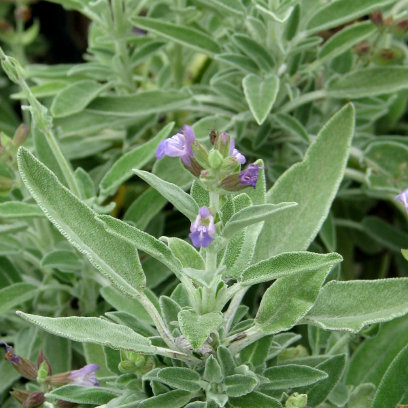Plant Specifications
Salvia officinalis X S. fruticosa (formerly S. triloba) Hardy Perennial. Full Sun. Height 18” – 32”.
A hybridization of S. Officinalis and Greek sage now cultivated in Israel features deeply lobed, fuzzy silver-like leaves. Tall flower spikes bloom with lavender pink, fragrant flowers. In the past, this sage was referred to as Greek sage, however this particular variety from Isreal, known as ‘Newe Ya’ar,’ withstands heat very well.
Salvia officinalis x S. fruticosa came to us in an unusual manner. In 1992, Members of the South Texas Unit of The Herb Society of America, Madalene Hill and Gwen Barclay purchased a bundle of herbs labeled as oregano from a local grocery store. As they more closely inspected the herbs, they realized that this was a woolly Salvia officinalis. This sage an appearance similar to S. fruticosa. They took the mysterious sage home and rooted all five cuttings. Four of the five cuttings were distributed to various growers for identification and research. The fifth cutting is growing happily in their garden. The identification was confirmed to be S. officinalis x S. fruticosa (S. triloba) by Dr. Arthur O. Tucker of Delaware State College. Madalene and Gwen instantly realized the value of this sage for our area when their plant survived a typical Texas Summer. The original plant is still growing well. The name Silver leaf sage was given as a working title for testing purposes, and is now known as Fruiticosa Sage.
In the Garden
This is another Sage that does very well in here in South Texas and thrives in dry, rocky hillsides due to te similarity of its geographical source. Dry, with some moisture is best as sages won’t do well in constant wet soil or wet conditions. To encourage busy growth, prune frequently. Plant sage where you can enjoy its fragrance and subtle flowers: at the front of a border or near a walkway. Fruiticosa sage can take the high heat and humidity in south Texas. This is one of the hardiest sages. This sage can become woody as it grows and needs to be ‘deadwooded’, trimming back the old woody stems to encourage new growth.
Plant Uses
Excellent for use in any recipes that call for Sage. The 3-4 inches of new growth can be harvested as required and used fresh, or they can be harvested before the flowers open and dried or distilled for their essential oil. This herb was used by the Phoenicians and Greeks for cooking and as a medicine. This sage has the most oils over the other sage. The high oil content makes it good for medicinal purposes.

